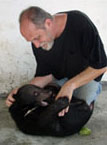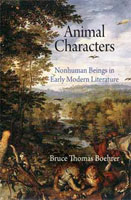 In the introduction to his recent publication, Animal Characters: Nonhuman Beings in Early Modern Literature (U of Pennsylvania P, 2010), Bruce Boehrer recounts the story of George Orwell sending his manuscript of Animal Farm to Dial Press in New York City for consideration to be published. Dial turned down Orwell because, according to a letter the English author later sent to his agent, and which Boehrer cites, "it was impossible to sell animal stories in the USA." Acknowledging that a mistake had been made, the publishing house soon after made an offer on the book, to which Orwell commented on in the letter, "I rather gather they had at first taken it for a bona fide animal story."
In the introduction to his recent publication, Animal Characters: Nonhuman Beings in Early Modern Literature (U of Pennsylvania P, 2010), Bruce Boehrer recounts the story of George Orwell sending his manuscript of Animal Farm to Dial Press in New York City for consideration to be published. Dial turned down Orwell because, according to a letter the English author later sent to his agent, and which Boehrer cites, "it was impossible to sell animal stories in the USA." Acknowledging that a mistake had been made, the publishing house soon after made an offer on the book, to which Orwell commented on in the letter, "I rather gather they had at first taken it for a bona fide animal story."
For Boehrer this anecdote "says something about the uncomfortable relationship between nonhuman animals and modern notions of literary character," and in Animal Characters, he examines that relationship with a focus on five species: the horse, the parrot, the cat, the turkey, and the sheep. His period of study is between 1400 and 1700, and Boehrer relies on written and visual records to explain not just how those animals lived and died, but also how Europeans were changing the way they interacted with them and how animals were being portrayed in a range of texts.
 "My book follows the fate of these beasts through the work of the age's greatest authors—Shakespeare, Milton, Cervantes, Ariosto, Rabelais, and more—as well as through husbandry manuals and exploration narratives, paintings and cookbooks, public processions and private menageries," Boehrer says, in an online interview with Rorotoko.com. "In the process, it recounts how these breeds of animal changed, both literally and figuratively, at the dawn of the modern age."
"My book follows the fate of these beasts through the work of the age's greatest authors—Shakespeare, Milton, Cervantes, Ariosto, Rabelais, and more—as well as through husbandry manuals and exploration narratives, paintings and cookbooks, public processions and private menageries," Boehrer says, in an online interview with Rorotoko.com. "In the process, it recounts how these breeds of animal changed, both literally and figuratively, at the dawn of the modern age."
In his introduction, he explains the basis for choosing the five animals he studies in Animal Characters: "they represent each of the three principal uses to which early modern Europeans put the beasts in their lives: haulage, companionship, and food."
"When it comes to social roles and associations, the animals I've chosen to study appear against different historical backgrounds and for different reasons," Boehrer says. "Exotic and expensive, parrots serve as high-prestige commodities in the early modern period's growing luxury trade, and as such they were either kept in private zoological collections or as rare companion animals. Cats, on the other hand, figure in common households, where they serve as vermin-catchers before they gain acceptance as pets. The turkey starts out as an exotic and expensive food animal that is gradually domesticated across Europe over the course of the sixteenth and seventeenth centuries. The sheep, valued both for its wool and its flesh, gains additional symbolic status through its association with Christian sacrifice. The horse, prized for various reasons and bred with various purposes in mind, gradually loses its supreme importance as an instrument of warfare.
"But whether the beasts in question are associated with privilege or poverty, and whether they are used for food or clothing or companionship or haulage," Boehrer says, "they all develop over the course of the Renaissance, changing their meaning, their uses, and more generally their character in the process."
Although the research for Animal Characters is rooted in the Renaissance, Boehrer says that the book helps supply some background when modern day examples of animal mistreatment are discovered or other practices of how we regard animals are debated.
"Our treatment of nonhuman beings has grown into one of the more worrisome aspects of modern social practice, posing problems on the economic, ecological, dietary, and ethical levels," he says. "Destruction of habitat, species persecution, factory farming, zoo-keeping, animal experimentation, animal entertainment: these and related practices have grown markedly—some would say alarmingly—over the past five hundred years.
"Animal Characters draws inspiration from the idea that our humanity is nowhere put more clearly on display, for better and for worse, than in our encounters with nonhuman life. To this extent, the book contributes to a broad and ongoing conversation about how we relate to the natural world and its other living creatures."

